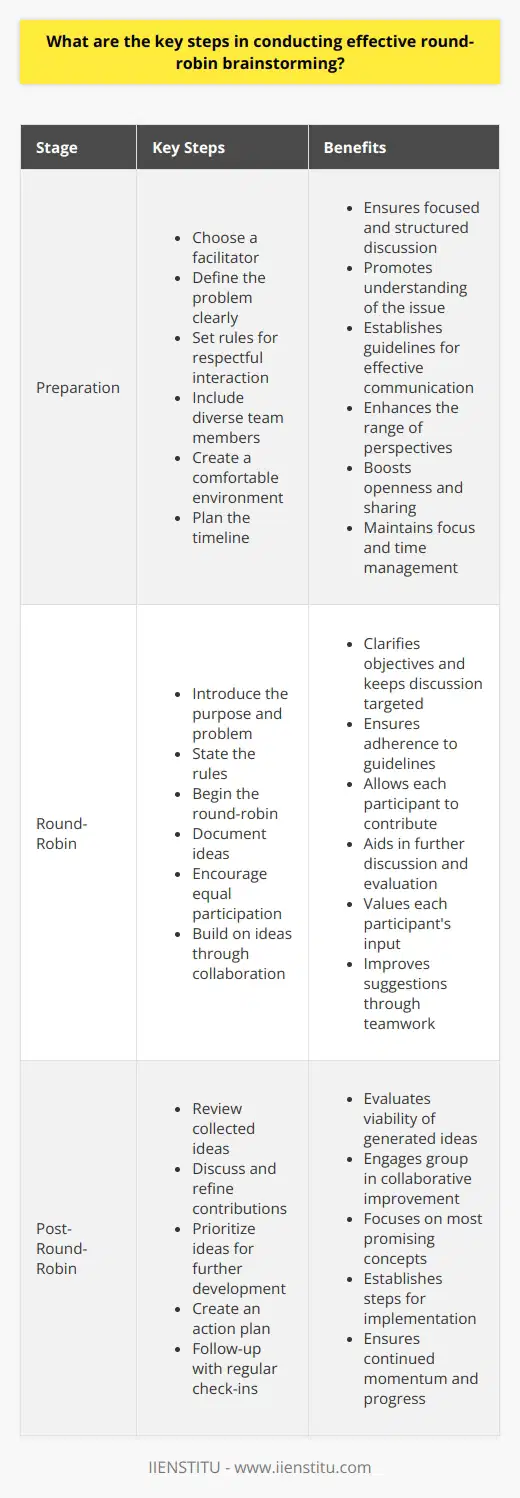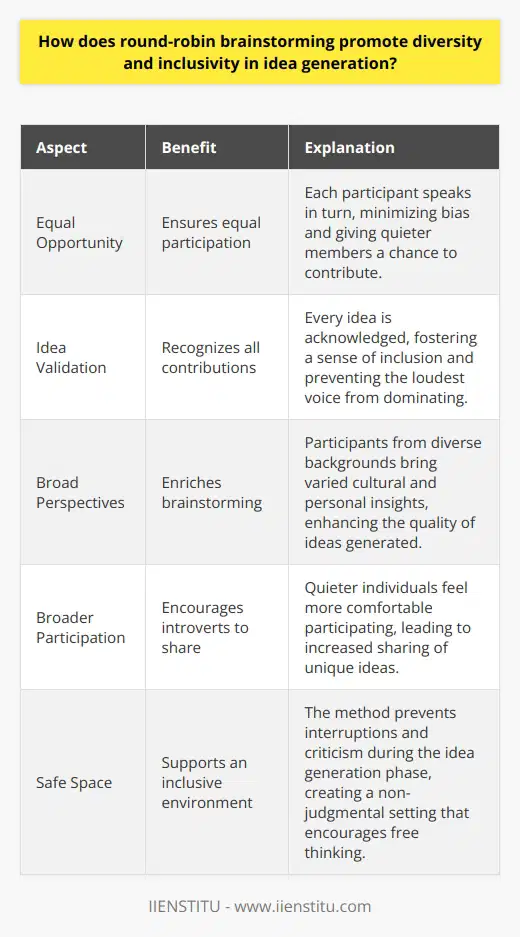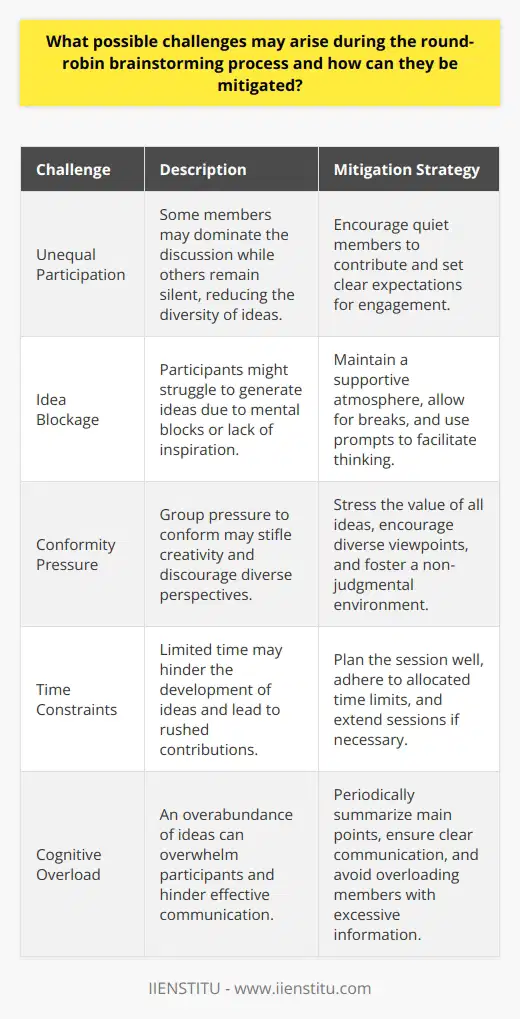
Round-Robin Brainstorming is a structured method designed to enhance the generation of ideas by ensuring equitable participation among all group members. At its core, this technique rotates the opportunity to speak, guaranteeing time and space for each participant to present and build on concepts without the common issue of more assertive members dominating the conversation. Recognizing its value, professionals in various industries and academic environments are increasingly seeking proficiency in this approach to optimize collaborative sessions.
The importance of effective idea generation spans countless settings – from corporate boardrooms to university think tanks. As challenges become more complex, the necessity of drawing from a diverse array of perspectives is clear. In turn, the ability to master brainstorming techniques has evolved into an essential skill, highly sought after by employers and valued in team members.
In cultivating these skills, taking a problem solving course or enrolling in an online MBA course can be instrumental. These educational avenues provide structured environments to practice and refine brainstorming methods, laying the foundation for dynamic and effective problem-solving abilities in professional scenarios.
The Methodology of Round-Robin Brainstorming
A proper Round-Robin Brainstorming session follows a well-defined sequence of steps, ensuring that every voice is heard, and every idea is given attention. Initiation begins with a clear understanding of the problem at hand and the goals of the session. This clarity sets the stage for unbiased ideation, where individuals are primed to share and iterate upon a myriad of concepts.
Roles within these sessions are critical: a facilitator to guide the process, time-keepers to maintain pace, and participants prepared to contribute. Each role shoulders the responsibility of keeping the session aligned with its intended purpose while fostering a supportive environment for creative thinking.
Time limits and rules, crucial facets of the technique, assure that discussions remain within scope and on track. Participants are often given equal time to articulate their ideas, ensuring distribution of opportunity and preventing the discourse from drifting into tangential or dominant narratives. This highly organized structure is a pivotal aspect of the Round-Robin Brainstorming methodology.
The Benefits of Using Round-Robin Technique
The advantages of the Round-Robin approach in fostering inclusivity cannot be overstated. By design, it removes obstacles that might inhibit some individuals from participating, such as the natural reticence of introverted personalities or the unintentional overshadowing by more extroverted members. Each participant's input is valued equally, leading to a more varied and comprehensive pool of ideas.
Moreover, this technique is a stalwart mechanism against the digression of topics customary in less structured discussions. Group discussion strategies are honed as participants learn to focus on the issue at hand, sequentially building upon each other's contributions in a methodical manner.
Ishikawa Diagram: A Comprehensive Guide to Cause and Effect Analysis
Jidoka (Autonomation): Introducing Efficiency in Modern Industries
In rounds of conversation, the process not only maintains topic relevance but also encourages a breadth of contributions that might otherwise be lost. This egalitarian structure democratizes the floor, validating every suggestion and bolstering a sense of team cohesion and mutual respect.
Round-Robin vs. Traditional Brainstorming
When contrasted with traditional, unmoderated brainstorming sessions, Round-Robin Brainstorming shines in its organizational strength and equitable framework. The stark differences become apparent when analyzing outcomes such as participant engagement and the variance of ideas produced.
In scenarios demanding equitable input from varied expertise or hierarchical levels—such as cross-functional team meetings or educational group projects—Round-Robin is notably effective. Its inherent structure ensures that various perspectives are expressed and heard, which is essential in harnessing the collective intelligence of the group.
Mastering Brainstorming Techniques
Facilitating a Round-Robin Brainstorming session is a skill that can be honed over time, through understanding group dynamics and the nuances of guiding discussions. Effective facilitators can preemptively identify and mitigate common obstacles, such as dominance by certain members or participants straying off-topic, thereby keeping the session's momentum steady and purpose-driven.
One of the prime challenges in Round-Robin Brainstorming is ensuring that each idea is given due consideration and that the session cultivates an environment where creativity is rewarded. In the aftermath, synthesizing these ideas into actionable items requires a keen analytical eye and a knack for spotting patterns and potentials in the array of contributions.
Techniques for effective synthesis include categorization, thematic grouping, and prioritization exercises. These methods help in distilling the brainstorming session's outcomes into practical steps forward, setting the stage for implementation and further refinement of the creative solutions.
Fostering Productivity in Ideation
Keeping a group focused and productive during a brainstorming session is often as challenging as it is crucial. Facilitators must use strategies such as setting clear objectives and keeping time-bound rounds to maintain a sense of progression and urgency.
Recording and organizing ideas as they are generated is an essential aspect of maximizing productivity. This record not only serves as a tangible outcome of the session but also as a foundation for subsequent reflection and development. The facilitator must adeptly manage the documentation, which can be as simple as maintaining a visual log on a whiteboard, or as complex as utilizing digital collaboration tools.
The art of constructive feedback and idea amplification is foundational in fostering a productive brainstorming atmosphere. Encouraging participants to build upon the suggestions of their peers can lead to the enhancement and maturation of concepts, instigating a collaborative evolution of ideas.
Leveraging Group Dynamics for Enhanced Creativity
Understanding and utilizing group dynamics play an essential role in maximizing the creative output of a brainstorming session. By acknowledging individual strengths, experiences, and styles of communication, a facilitator can harness these diversities to foster richer and more varied exchanges.
Inviting a spectrum of perspectives is particularly potent in unveiling unconventional solutions. A group composed of varied disciplines, expertise levels, and backgrounds can unearth ideas that may not surface in a more homogenous congregation.
Assessing the group's performance post-session is a critical step in continuous improvement. Reflecting on what strategies worked, what dynamics emerged, and how effectively ideas were generated and recorded provides a blueprint for further enhancing future brainstorming sessions.
Case Studies and Examples
By dissecting real-world applications of Round-Robin Brainstorming, we can glean insights into its tangible benefits. Numerous case studies provide evidence of how this technique has steered groups toward innovative solutions, resolving complex problems that previously seemed insurmountable.
For instance, businesses have utilized Round-Robin Brainstorming to break through creative blockades and devise groundbreaking products. Academic settings have leveraged this approach to facilitate cross-disciplinary research initiatives, leading to breakthroughs in understanding and application.
These examples provide a wealth of lessons to be implemented in future sessions—a testament to the effectiveness of the Round-Robin Brainstorming method. By studying these successes and adjusting one's approach accordingly, facilitators and participants alike can refine their collaborative ideation process.
Integrating Round-Robin Brainstorming into Regular Practice
Mastering Round-Robin Brainstorming is an endeavor that requires practice, reflection, and adaptability. Key takeaways from exploring this technique include understanding the importance of structure, recognizing the value of every participant, and the necessity of thorough post-session analysis.
Regularly integrating Round-Robin Brainstorming into group discussion strategies secures its position as an essential tool for ideation. As with any skill, iterative practice is vital; each session offers an opportunity for improvement and deeper understanding of the subtleties involved in effective brainstorming.
Concluding on a note of encouragement, utilizing Round-Robin Brainstorming techniques promises to enrich group creativity and productivity. With each session, teams become more adept at navigating the complexities of collaboration and arriving at innovative solutions.
Further Resources and Learning
For those motivated to deepen their expertise in brainstorming techniques, numerous books, articles, and tools are available. Each resource offers different perspectives and methodologies that can enhance one's approach to idea generation.
Sharing experiences with fellow Round-Robin Brainstorming practitioners can be invaluable. Such exchanges provide real-world insights and foster a community dedicated to continuous learning.
Lastly, to remain at the forefront of ideation, it is crucial to stay attuned to evolving methods and be willing to adapt techniques for optimal results. The pursuit of mastery in brainstorming is an ongoing journey, one that rewards the dedicated with unparalleled collaborative achievement.
Frequently Asked Questions
What are the key steps in conducting effective round-robin brainstorming?
Introduction to Round-Robin Brainstorming
Round-robin brainstorming fosters inclusive participation. It ensures that all team members contribute equally. Participants share ideas in turns. This creates a structured dialogue.
Preparing for the Session
Choose a Facilitator
Select one person to guide. This individual keeps the conversation on track.
Define the Problem
Clearly state the issue or question. Everyone should understand it.
Set Rules
Establish clear guidelines. These are vital for respectful interaction.
Choose Participants
Include diverse team members. This enhances the range of perspectives.
Create a Comfortable Environment
Ensure the setting is conducive to sharing. Comfort boosts openness.
Plan the Timeline
Allocate specific times for each step. This maintains focus.
During the Round-Robin
Introduce the Purpose
Start by explaining goals. Clarity on objectives is crucial.
Present the Problem
Remind everyone of the issue. Keep the discussion targeted.
State the Rules
Review guidelines before starting. Ensure adherence.
Begin the Round-Robin
Participants suggest ideas in order. Each person gets a turn.
Document Ideas
Write down all contributions. Visibility aids in further discussion.
Encourage Equal Participation
Ensure each voice is heard. Balance is key.
Build on Ideas
Allow others to expand contributions. Collaboration improves suggestions.
After the Round-Robin
Review Collected Ideas
Go over the documented contributions. Evaluate for viability.
Discuss and Refine
Engage in a group dialogue. Aim to improve ideas.
Prioritize
Decide which ideas to develop further. Use consensus.
Create Action Plan
Draft steps to implement the best concepts. Assign responsibilities.
Follow-Up
Set up meetings to track progress. Regular check-ins ensure momentum.
Round-robin brainstorming taps into collective insights. It values each participant's input. By following these steps, teams can unlock innovative solutions together.

How does round-robin brainstorming promote diversity and inclusivity in idea generation?
What is Round-Robin Brainstorming?
Round-robin brainstorming is a structured method. It involves each participant in turn. This aids in a more democratic idea-sharing process. Individuals can't dominate the discussion. Every voice gets an equal hearing. This approach also limits groupthink. Groupthink can stifle creativity.
Promoting Diversity and Inclusivity
Equal Opportunity
Every participant speaks one by one. This ensures equal opportunity. Ideas from all get considered. It minimizes bias and gives quieter members a voice.
Idea Validation
The round-robin method validates all contributions. It doesn't rank opinions by the loudest voice. Every idea gains recognition, fostering a sense of inclusion.
Broad Perspectives
People from diverse backgrounds participate. This brings in varied perspectives. It enriches brainstorming with cultural and personal insights.
Broader Participation
Introverts often avoid traditional brainstorming. Round-robin encourages broader participation. Quieter people feel more comfortable. They share more.
Reducing Conformity
Participants express ideas without immediate group feedback. This reduces the pressure to conform. Unique ideas flourish.
Safe Space
Creating a safe space is crucial. Round-robin methods contribute to this. They prevent others from interrupting or criticizing. This supports an inclusive environment.
Inclusive Idea Generation
Idea Equity
Every idea gets equal consideration. This is called idea equity. It removes the influence of hierarchy. It makes brainstorming more democratic.
Fostering Creativity
All participants add ideas independently. This fosters creativity. Diverse ideas blend together. The result is innovative solutions.
Non-Judgmental Setting
The process emphasizes a non-judgmental setting. Critiques happen after all ideas are out. This encourages free thinking.
Idea Ownership
Everyone feels a sense of idea ownership. It leads to increased engagement. It boosts the desire to contribute.
Round-robin brainstorming supports diversity and inclusivity. It allows every member to contribute. This maximizes the range of ideas. A diversity of thought thrives. Everyone feels included and valued. Round-robin isn’t just a technique. It symbolizes a commitment to inclusive practices in brainstorming sessions. It ensures that the generation of ideas is a collective and respected process.

What possible challenges may arise during the round-robin brainstorming process and how can they be mitigated?
Challenges of Round-Robin Brainstorming
Round-robin brainstorming is a structured method. It allows equal participation. However, it can face challenges. Recognizing these challenges is crucial. Addressing them effectively is as well.
Unequal Participation
Some members may dominate. Others may stay silent. This imbalance reduces idea diversity. Encouraging quiet members helps. Set clear expectations for engagement.
Idea Blockage
Participants might struggle to generate ideas. This is called idea blockage. Keep the atmosphere supportive. Allow for breaks. Use prompts to facilitate thinking.
Conformity Pressure
There is pressure to conform in groups. It may stifle creativity. Stress that all ideas are valuable. Diverse perspectives enrich brainstorming. Aim for a non-judgmental environment.
Time Constraints
Time is often limited. Ideas may need more time to develop. Plan the session well. Keep to the allocated time for each person. Extend sessions if necessary.
Cognitive Load
Many ideas can overwhelm participants. Too much information becomes a problem. Summarize main points periodically. Ensure clear communication. Avoid overloading members.
Social Loafing
Some may rely on others to contribute. This is social loafing. Encourage individual accountability. Highlight the importance of each contribution. Monitor participation levels.
Off-Topic Discussion
Discussions can stray. They become off-topic. Stay vigilant as a facilitator. Gently steer conversations back. Maintain focus on the task.
To mitigate these challenges:
- Ensure equal turns: Every member speaks in turn.
- Build a supportive environment: Reduce fear of judgment.
- Impose time limits: Keep contributions concise.
- Restate and summarize: Clarify and refresh memories.
- Assign roles: Each member has a specific role.
- Use prompts: Aid those with idea blockage.
- Encourage individual accountability: Stress each person's importance.
Embracing these strategies promotes effectiveness. Round-robin brainstorming becomes more fruitful. It leads to a plethora of innovative ideas.



